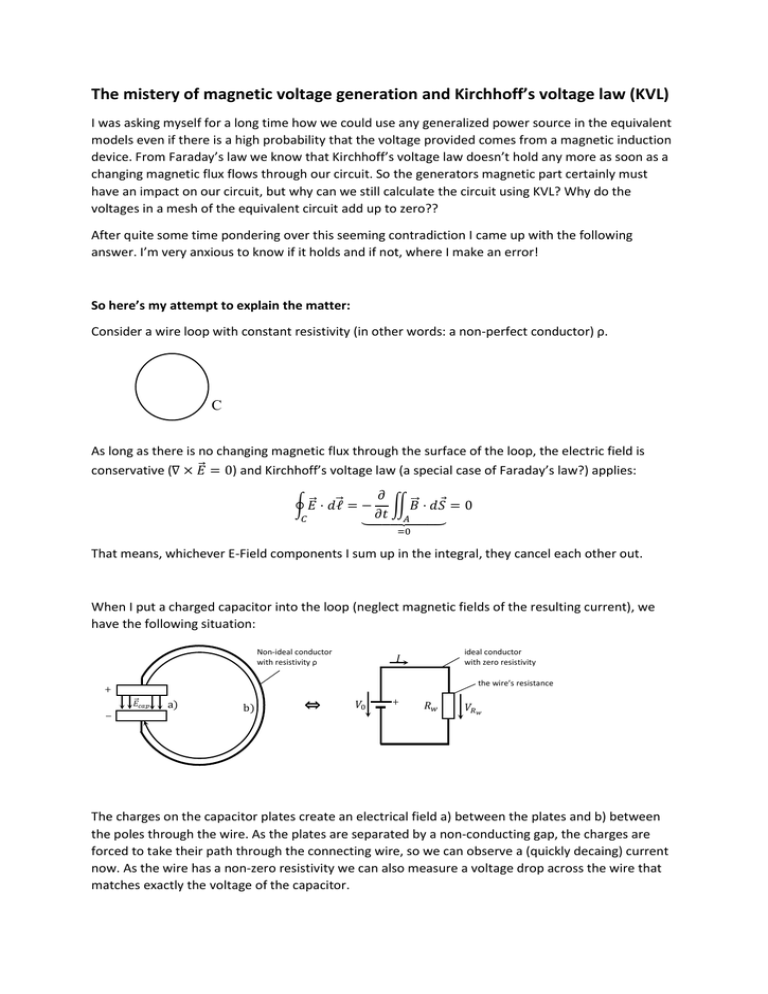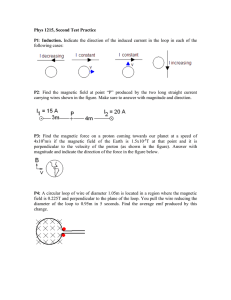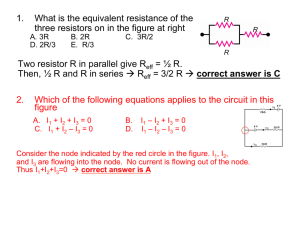The mistery of magnetic voltage generation and Kirchhoff`s voltage law
advertisement

The mistery of magnetic voltage generation and Kirchhoff’s voltage law (KVL) I was asking myself for a long time how we could use any generalized power source in the equivalent models even if there is a high probability that the voltage provided comes from a magnetic induction device. From Faraday’s law we know that Kirchhoff’s voltage law doesn’t hold any more as soon as a changing magnetic flux flows through our circuit. So the generators magnetic part certainly must have an impact on our circuit, but why can we still calculate the circuit using KVL? Why do the voltages in a mesh of the equivalent circuit add up to zero?? After quite some time pondering over this seeming contradiction I came up with the following answer. I’m very anxious to know if it holds and if not, where I make an error! So here’s my attempt to explain the matter: Consider a wire loop with constant resistivity (in other words: a non-perfect conductor) ρ. C As long as there is no changing magnetic flux through the surface of the loop, the electric field is conservative (∇ × 𝐸⃗ = 0) and Kirchhoff’s voltage law (a special case of Faraday’s law?) applies: 𝜕 ⃗ = − ∬𝐵 ⃗ ⋅ ⅆ𝑆 = 0 ∮ 𝐸⃗ ⋅ ⅆℓ ⏟ 𝜕𝑡 𝐴 𝐶 =0 That means, whichever E-Field components I sum up in the integral, they cancel each other out. When I put a charged capacitor into the loop (neglect magnetic fields of the resulting current), we have the following situation: Non-ideal conductor with resistivity ρ ideal conductor with zero resistivity 𝐼 the wire’s resistance + a) b) ⇔ 𝑉0 + 𝑅𝑤 0 𝐸⃗𝑐𝑎𝑝 − 𝑉𝑅𝑤 0 The charges on the capacitor plates create an electrical field a) between the plates and b) between the poles through the wire. As the plates are separated by a non-conducting gap, the charges are forced to take their path through the connecting wire, so we can observe a (quickly decaing) current now. As the wire has a non-zero resistivity we can also measure a voltage drop across the wire that matches exactly the voltage of the capacitor. In the equivalent circuit model we 1) hide the internals of the capacitor and display it as a general voltage source and 2) concentrate the continuous voltage drop across the wire in one resistor in series. This corresponds perfectly to the Kirchhoff’s voltage law: ⃗ = 0 = 𝑉0 − 𝑉𝑅 ∮𝐸⃗ ⋅ ⅆℓ 𝑤 ⇔ 𝐶 𝑉0 = 𝑉𝑅𝑤 Now comes the tricky part where I’m not sure if I get it right… Take again the closed wire but this time let a changing magnetic flux permeate the enclosed area of the circle. Faraday’s law states ⃗ =− 𝑉𝑖𝑛𝑑 = ∮ 𝐸⃗ ⋅ ⅆℓ 𝜕𝐴 ∂A A ⃗ 𝐵 𝜕 ⃗ ⋅ ⅆ𝑆 ∬𝐵 𝜕𝑡 𝐴 This means that if we sum up all the E-field components along the wire we won’t get zero but an 𝜕 ⃗ (𝑟, 𝑡)). induced voltage that corresponds to the curl of the electric field (∇ × 𝐸⃗ (𝑟, 𝑡) = − 𝐵 𝜕𝑡 Where do the electric field components originate? An inductivity whose external flux is changed will try to compensate it by applying a magnetic flux of its own. This corresponds to a current flowing through the inductivity whose voltage will adjust according to the total resistance of the electric loop (an inductivity will induce a huge voltage when disconnected abruptly (𝑅 → ∞) so that it can maintain the continuity of the current/magnetic flux). 𝑉𝑖𝑛𝑑 = − 𝑉1 𝜕 Φ 𝜕𝑡 𝑚𝑎𝑔,𝑒𝑥𝑡 𝑉2 ⃗ 𝐵 So we can look at the wire as a series of infinitesimal small resistors 𝑅𝑖 where each one contributes a small voltage drop along the loop until we have the full 𝑉𝑖𝑛𝑑 when we close the path. 𝑉3 etc If we then open the loop and insert a resistor 𝑅𝐿 with 𝑅𝐿 ≫ 𝑅𝑖 at the loose ends it must be obvious that almost the whole 𝑉𝑖𝑛𝑑 drops over 𝑅𝐿 (a). In this setting 𝑉𝑅𝐿 should only change by a negligible amount if we relocate 𝑅𝐿 to a faraway distance from the circle (b), as the added area that is enclosed in the rectangle between the connecting wires is very small and we assume the magnetic flux to ⃗ to integrate over anyway. decay over distance, so there is not much 𝐵 𝑉1 𝑉2 𝑉1 𝑉2 𝑅𝐿 ⃗ 𝐵 a) 𝑅𝐿 𝑉𝑅𝐿 ⇒ 𝑉𝑅𝐿 ⃗ 𝐵 b) + − ideal conductor 𝐼 0 with zero resistivity We can finally make the last step and transition to the the wire’s resistance generalized equivalent circuit where we assume the wire + to have perfect conductivity and thus all the induced 𝑉𝑖𝑛𝑑 𝑅𝐿 𝑉𝑅𝐿 − voltage drops over 𝑅𝐿 . In order to represent the loop (and its surface area) that “generates” the induced voltage, we assign it a voltage source symbol and a source voltage (might as well be the generator of your neighboring nuclear power plant). And this is how Kirchhoff’s voltage law magically works again. Even with a generator as power source. 0 = 𝑉𝑖𝑛𝑑 − 𝑉𝑅𝐿 ⇔ 𝑉𝑖𝑛𝑑 = 𝑉𝑅𝐿



